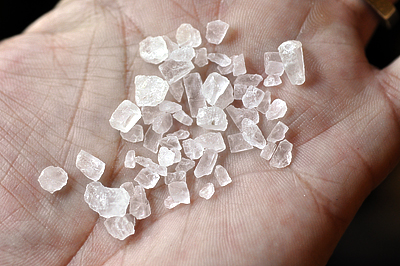Minerals that break in flat, smooth planes are said to have cleavage. Like many things in science, this is much easier to understand if you actually see it, so lets do an experiment.
You will need:
Materials:
- table salt
- course or rock salt
- a magnifying glass
- a hammer
- a paper towel
Lets start by taking a close look at some table salt. Sprinkle a few grains of salt into your hand and look at them closely. If you have a magnifying glass, you can use that to get an even closer look. Even without the magnifying glass, you should be able to see that each of the grains is a tiny cube. With a magnifying glass or a microscope, you can see that even the tiny bits of salt are cubes.

Next, look at some rock salt. Rock salt has much larger pieces, and it is commonly used in making home-made ice cream (yum!) and in melting the ice on sidewalks. Looking at the pieces, you will notice that again, they are cubes. Pick out a large piece of salt, and use a hammer to gently break it. You don't want to smash it into tiny bits. Instead, try to break it into three or four fairly large pieces. Notice the shape of the pieces. They also tend to be cubes, and the sides are flat and smooth. Use the hammer to break those pieces into smaller pieces. Using the magnifying glass, you will see that those smaller pieces are also cubes, with flat, smooth sides. If you have access to a microscope, try powdering some of the salt into very fine powder. Look at them under the microscope, and again, you will find that the pieces form cubes.
Why does salt break this way? Salt is a mineral called halite, and like many other minerals, it has a property known as cleavage. Cleavage means that the mineral contains weaknesses that cause it to break easier in one direction than in another. Some minerals, such as mica, only cleavage in only one direction. They tend to break into thin, flat sheets. Salt, which is also known as the mineral halite, has cleavage in three directions. This causes the salt to break into cubes.
A model to show how cleavage works
You can get an idea of how these weaknesses work by tearing a paper towel. Starting at the top where it was attached to the other towels, make a tear about an inch from the edge. Hold the top of the sheet in one hand and the top of the torn strip in the other and pull. The strip should tear easily, all the way to the bottom of the towel. The paper that paper towels are made from has weaknesses that run from the top of the sheet to the bottom. Now, try using the same method to tear a strip from one side of the paper to the other. You will find that it is much more difficult to get the strip to tear all the way across the sheet. You are trying to tear across the weaknesses, and the tear keeps trying to follow these weaknesses.
While the weaknesses of the paper towel are caused by the way the paper is manufactured, the weaknesses in the salt are part of the crystalline structure. As the molecules fit together, they line up in rows, forming planes of weakness through the mineral. If the molecules do not line up in rows, then the mineral will not have cleavage.
Directions of cleavage
Depending on how their molecules fit together, a mineral may have cleavage in more than one direction. Minerals that only have one or two directions of cleavage will have fracture in the directions that do not have cleavage, but they will never have a conchoidal fracture. If a mineral has more than three directions of cleavage, it may be difficult for you to count them.
WARNING!
Tips on Testing
- Be very careful of sharp edges.
- Always wear eye protection when breaking rocks or minerals.
- Remember that even if a mineral has cleavage in one direction, it may have fracture in a different direction.
Tips on Testing
- Before you start breaking your specimen, look at it carefully. Hold it in a bright light and turn it until the light glares off the surface. If all the parts of the specimen glare at the same time, then it probably has cleavage in that direction. This can be very helpful if you don't want to break your specimen.
- Opposite sides always show the same plane of cleavage. If one side seems to have cleavage, and the other side does not, then it is probably not cleavage. When you are counting directions of cleavage, each pair of opposite sides counts as one direction.
- Remember that if the specimen has any conchoidal fractures, it usually does not have cleavage.
- Don't mistake crystal sides for cleavage. Remember that crystals are the way that the mineral forms. Cleavage is the way that it breaks.
